How long does a dental implant take? This question often lingers in the minds of individuals considering options for tooth replacement. Losing a tooth can significantly affect one’s confidence, oral health, and even everyday activities like eating or speaking. Fortunately, dental implants present a durable and aesthetically pleasing solution to missing teeth. However, it’s essential to recognize that obtaining a dental implant is not an instantaneous fix. Instead, it involves multiple stages, each with its own timeline. Understanding these phases and the factors influencing the overall duration can help manage expectations and prepare for a successful outcome.
Understanding the dental implant process
The journey of dental implant placement resembles a carefully orchestrated symphony, combining various instruments (phases) to produce a harmonious result—a fully restored smile. At the core of this process lie three main components: the implant itself (a titanium post surgically inserted into the jawbone), the abutment (which connects the implant to the crown), and the crown (the artificial tooth that mimics the appearance and function of a natural tooth).
Getting a dental implant typically unfolds across three primary phases, with each needing specific procedures and healing periods. The entire journey from consultation to complete restoration can span several months, sometimes extending over a year, depending on various individual factors. Let’s delve deeper into each phase to shed light on how long does a tooth implant take and what to expect during the process.
Phase 1: The extraction and placement of the implant
The first phase focuses on creating a solid foundation for the implant through extraction if required and then surgically placing the implant into the jawbone. This phase is critical for ensuring the long-term success of the implant, as it establishes the groundwork for what follows.
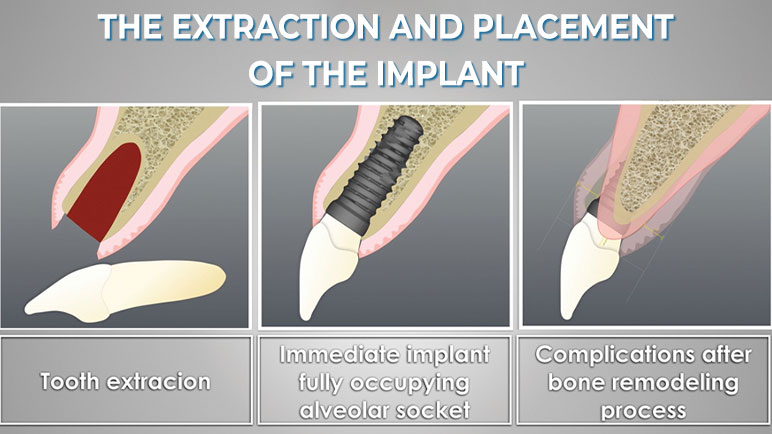
Preparing the jawbone for implant placement
Before placing the implant, it’s vital to assess the condition of the jawbone. An important aspect here is bone density and quality—if the bone lacks sufficient density due to prolonged tooth loss or other reasons, it may not adequately support the implant. In such cases, a bone grafting procedure might be necessary.
Bone grafting entails adding bone material to the area where the implant will be placed, enhancing volume and density. Although this can add several months to the overall timeline, it ultimately contributes to the stability and durability of the implant. After grafting, enough healing time is crucial before progressing to the next step, which can take anywhere from three to six months, depending entirely on the individual’s healing capacity.
Implant placement surgery
Once the jawbone is determined to be suitable for placement, the surgical procedure can commence. The dentist creates a small incision in the gum tissue, exposing the jawbone for precision drilling. A hole is drilled into the bone, allowing the titanium implant to be securely screwed into place.
This procedure typically lasts around 30-60 minutes per implant, although the actual duration can vary based on individual circumstances and potential complications. Following surgery, the gum tissue is sutured closed around the implant, leading into a critical period of healing.
Healing and osseointegration
Post-surgery marks the start of the osseointegration process, where the titanium implant fuses with the surrounding bone, forming a solid bond. This bonding is paramount for the success of the dental implant, ensuring a secure anchor within the jawbone.
Generally, osseointegration takes about 3 to 6 months, depending on a variety of factors such as the individual’s age, overall health, and the quality of the bone. It’s essential for patients to adhere to post-operative instructions diligently to foster optimal healing and mitigate any risk of complications.
Phase 2: Abutment placement
Upon successful osseointegration, the next phase entails the placement of the abutment. This stage is relatively straightforward but plays a vital role in the overall process, connecting the implant to the dental crown.
The abutment’s role in implant restoration
The abutment acts as a crucial connector between the titanium implant and the crown. Typically made from metal or ceramic, it provides a stable platform for the crown to attach securely. Besides functionality, the abutment also aids in positioning the crown appropriately concerning the neighboring teeth, restoring bite and aesthetics.
Moreover, careful selection of the abutment can directly impact the success of the restoration. Depending on the location of the implant and aesthetic considerations, dentists may choose different types of abutments to achieve the best results. The choice between different materials and designs could affect the overall look and feel of the final restoration too.
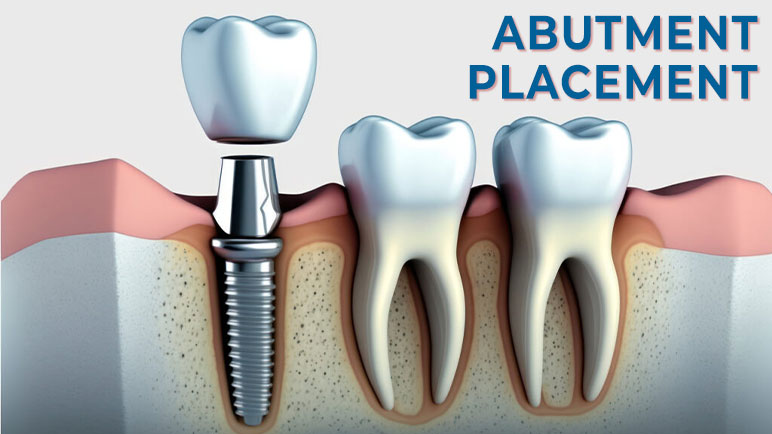
Abutment placement procedure
Placing the abutment is generally a minor, quick procedure. The dentist uncovers the implant, which may have been concealed by gum tissue during the healing period. After securing the abutment onto the implant, an impression of the abutment and surrounding teeth is taken. This impression is vital for crafting a custom-designed crown that seamlessly fits the patient’s mouth.
While the abutment placement doesn’t require extensive downtime, some patients may still experience slight discomfort, which should subside quickly. By following post-care instructions diligently, patients can ensure a smooth transition to the final restorative phase.
Phase 3: Restoration and crown placement
The concluding phase of the dental implant process revolves around placing the dental crown, completing the restoration journey. It’s pivotal as this phase not only restores functionality but also reinstates the natural aesthetic of the patient’s smile.
Choosing the right dental crown
Selecting the appropriate dental crown is integral to achieving a natural-looking result. Crowns are commonly fabricated from porcelain, ceramic, or a combination of materials, tailored to match the shade and texture of existing teeth successfully. Dentists collaborate with patients to ascertain their preferences while considering functional requirements and esthetics.
Factors such as location of the implant influenced the choice of material; for example, anterior (front) crowns often necessitate more emphasis on aesthetics compared to posterior (back) crowns where durability may take precedence. Ultimately, a thoughtful selection process ensures the crown not only looks good but also withstands daily wear and tear effectively.
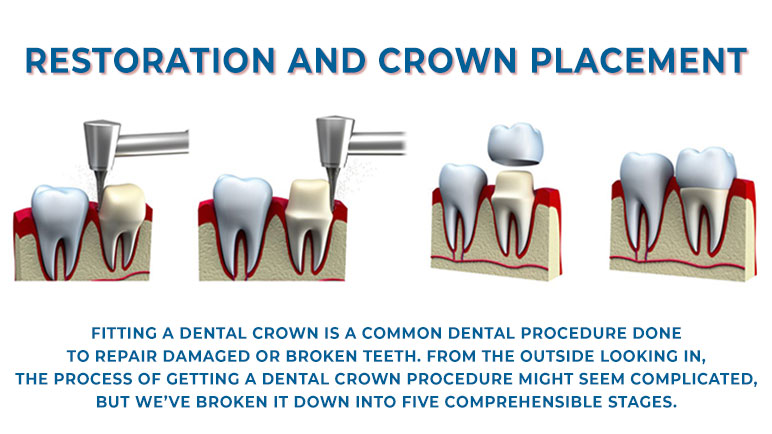
Crown fabrication and attachment
Once the impression is obtained, a dental laboratory fabricates the custom-made crown. Generally, this fabrication period spans a couple of weeks, after which the crown is ready for attachment. When the dentist receives the crown, they will attach it to the secured abutment, ensuring a proper fit and alignment with surrounding teeth.
Initially, temporary cement may be used to hold the crown in place while confirming that the fit and bite align correctly. Once confirmed, the crown is permanently affixed, culminating in a fully functional and aesthetically pleasing restoration.
Factors affecting dental implant timeline
Several factors influence the timeline of dental implants, contributing to variability in duration for each phase. Understanding these elements will empower patients to have realistic expectations throughout their journey.
Bone density and quality
The density and quality of the jawbone are pivotal factors. Patients with robust jawbones often complete the implant process quicker than those with compromised bone structure. If bone grafting is necessary due to resorption or insufficient density, it can extend the timeline significantly.
Assessment of bone density is a routine part of initial consultations, allowing dentists to create tailored treatment plans. Consequently, prospective patients should enter discussions with their dentists regarding any concerns related to bone health.
Number of implants needed
The number of implants required also bears weight on the overall duration of the process. Replacing a single tooth typically demands less time than replacing multiple teeth or constructing a full-arch restoration. Complex procedures necessitate additional surgeries and healing times, thus prolonging the overall timeline.
Patients should communicate openly with their dentists about their goals and expectations regarding the number of missing teeth, ensuring that comprehensive planning occurs well ahead of surgery dates.
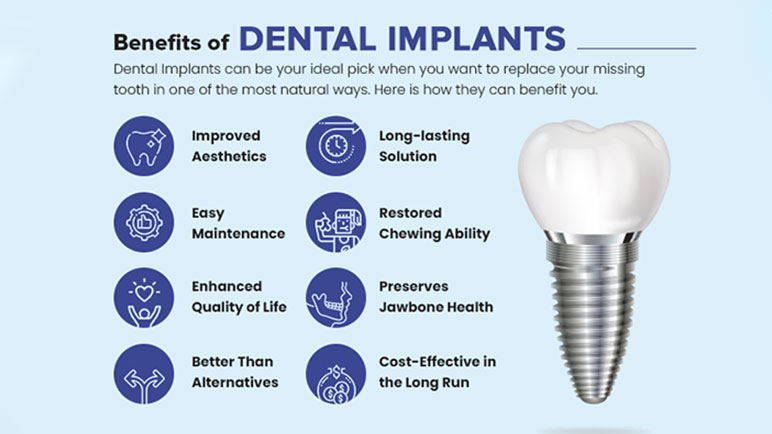
Patient’s overall health
A patient’s overall health critically impacts both healing times and potential complications. Conditions such as diabetes, autoimmune disorders, or chronic illnesses may slow down the healing process, necessitating longer wait times before progression to subsequent phases.
Open communication with the dentist about any underlying health issues is crucial. If needed, modifications to treatment plans or additional precautions may be implemented to optimize the chances of a successful outcome.
The healing process after implant placement
Following the implant procedure, careful attention to healing is essential for successful outcomes. This involves adherence to post-operative care instructions and diligent management of discomfort.
Post-surgery care instructions
After surgery, the dentist will provide specific post-operative care instructions. Adhering to these guidelines promotes healing and minimizes risk factors associated with infection or complications.
Some typical instructions include maintaining oral hygiene practices, gently cleaning the area around the implant site with a soft brush, and avoiding strenuous physical activity for several days. Additionally, patients are often advised to follow a soft food diet until comfortable chewing returns.
Medication management is another crucial aspect, encompassing prescribed pain relievers and antibiotics to handle pain and prevent infections. Avoiding harmful habits such as smoking and excessive alcohol consumption further supports a smoother recovery.
Managing pain and swelling
It’s common to experience some level of pain, swelling, or discomfort following the surgery. Utilizing cold compresses and adhering to prescribed medication can significantly alleviate these symptoms. Most patients find that swelling reduces and discomfort subsides within a few days, with some variance based on individual tolerance levels.
Persistent pain or abnormal symptoms should be addressed promptly with the dental professional to mitigate any risks. Understanding that some variability exists in recovery timelines allows patients to navigate post-operative experiences with patience and mindfulness.
Cost considerations for dental implants
Securing dental implants represents a significant financial investment. The costs involved can vary widely based on numerous factors, including complexity, number of implants, and the expertise of the dental professional.
Factors affecting implant cost
Various factors contribute to the overall cost of dental implants. The number of implants required directly correlates with price; replacing a single tooth is generally less expensive compared to larger restorations involving multiple teeth.
Additionally, even the type of implant can influence costs, as different materials and designs come with varying price points. Should bone grafting be necessary, this adds additional expense to the total procedure. Similarly, the geographic location and experience of the dental provider can lead to differences in pricing structures, making it imperative for patients to conduct thorough research.
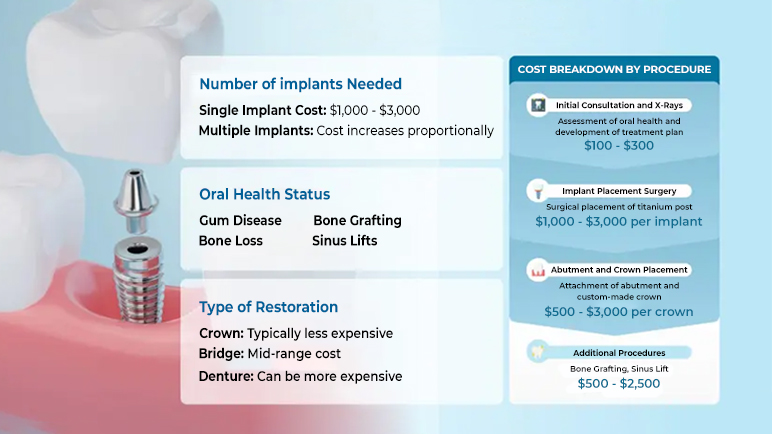
Insurance coverage for dental implants
Dental insurance policies vary significantly in terms of coverage for implants. Some plans may offer partial reimbursement, while others exclude dental implants altogether from coverage. Thus, it’s wise for patients to review their insurance plans meticulously prior to initiating treatment.
Engaging in open communication with the dental office about insurance-related inquiries can help clarify coverage aspects and potentially aid in the creation of financing plans that accommodate patients’ needs.
Is a dental implant right for you?
When contemplating dental implants, several considerations must be addressed to ascertain candidacy for this treatment option. While implants are a viable option for many, they may not suit everyone.
Evaluating your candidacy for implant treatment
Assessing candidacy for dental implants necessitates a comprehensive evaluation by a dental professional. Key factors include the health of the gums, the condition of the jawbone, and overall health status.
Individuals with gum disease, insufficient bone density, or certain medical conditions may require additional treatments or procedures before becoming candidates for implants. Thoroughly discussing personal dental history and health concerns with the dentist forms the basis for determining suitability.
Discussing your concerns with your dentist
An open dialogue with your dentist facilitates addressing any apprehensions or questions regarding the dental implant process. Understanding what to expect at each phase empowers patients, enabling them to make informed decisions about their treatment.
Seeking clarity on aspects such as the timeline, costs, and possible complications fosters a sense of partnership with the dentist, creating a supportive environment for embarking on the journey toward restoring one’s smile.
Conclusion
In conclusion, understanding how long dental implants take involves recognizing the intricacies of the multi-phase process. From initial assessments to implant placement, healing, and final restoration, various components contribute to the overall timeline.
Factors such as bone density, overall health, and the number of implants considerably influence the duration of treatment. Embracing patience and maintaining an open line of communication with dental professionals will ultimately facilitate a smoother journey toward regaining a confident smile.
Dental implants represent a powerful solution for those seeking to recover lost functionality and aesthetics, and with proper understanding and preparation, they can lead to remarkable improvements in quality of life.

 Google Reviews
Google Reviews Call
Call
SAIGON IMPLANT CENTER
Best dentist in Vietnam
Saigon Implant Center - Dental Clinic utilizes the latest technology for specialized treatment in the field of Single implant, full jaw implants, All on 4 implants, All on 6 implants, Zygoma implant....
SAIGON IMPLANT CENTER
Best dentist in Vietnam
Saigon Implant Center - Dental Clinic utilizes the latest technology for specialized treatment in the field of Single implant, full jaw implants, All on 4 implants, All on 6 implants, Zygoma implant....